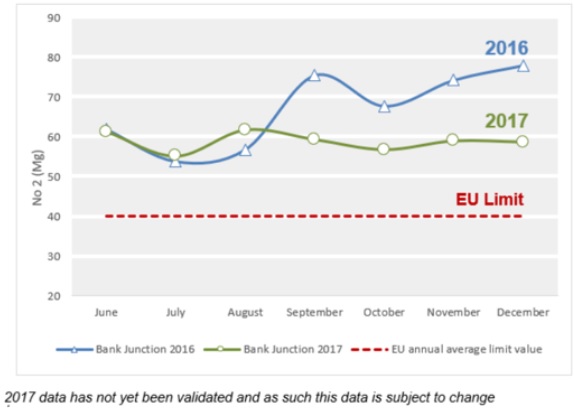Bank Junction sees air quality improvement
Improvements in air quality around Bank Junction, a busy road intersection in the City of London, may be linked to a trial restriction on road traffic at the location.
The ‘Bank on Safety’ scheme — which began in May 2017 — focuses on restricting the number of vehicles that cross the busy Bank Junction during the working day to significantly reduce the number of collisions.

Restrictions have been in place around Bank Junction since May 2017
As part of the 18-month trial initiative, which has been coordinated by City of London Corporation, only buses and pedal cyclists are allowed to cross the junction between 7 am and 7 pm.
Provisional data to the end of March 2018 has recently been received and this indicates that for the 10 months of operation there has been a 52% reduction in the number of casualties when compared to the five-year average (7 casualties vs 14.4 average).
The City of London Corporation has also monitored the concentrations of nitrogen dioxide pollution — one of the major pollutants linked to road traffic — which has indicated that there has been an improvement in air quality at the location.
Monitoring
According to figures published by the local authority, gleaned from diffusion tube readings taken since the start of the scheme, NO2 concentrations have dropped — but remain at levels above the legal limit.
In its report, the authority noted: “…the first six months of data was available in the latest performance report and showed that on average NO2 had decreased at Bank and in the surrounding area compared to the 2016 readings. It should be noted that this data cannot be split between scheme and non-operational hours.”
Despite the improvement, City of London has urged caution in drawing a definite link between the trial scheme and the drop in the levels of NO2 monitored around the junction.

Source: City of London Corporation
The report added: “This measure is difficult to capture accurately because of the number of things that can impact on the readings including weather, traffic diversions and missing diffusion tubes. However, the first six months of data was available in the latest performance report and showed that on average NO2 had decreased at Bank and in the surrounding area compared to the 2016 readings. “
Commenting on the scheme, Chris Hayward, Chairman of the City of London Corporation’s Planning & Transportation Committee, said: “I have always said that our number one priority for the experimental scheme at Bank junction is to improve safety.
“That is why I am delighted to see the scheme succeed in reducing collisions and improving air quality. A busy junction used by 18,000 pedestrians every hour at rush hour; it has been a pleasure to see members of the public truly begin to enjoy this iconic area.
“Efforts to inform the public of the restrictions have been ongoing and extensive. The number of vehicles travelling through the junction between 7am and 7pm has reduced from 16,000 to just over 500 contravening vehicles a day. This equates to 97% compliance to the scheme.
“We have been in listening mode throughout and with a noteworthy number of consultation responses, the wide-ranging needs of local road users and stakeholders will be considered along with the operational needs of the City.”
From Monday (21 May), the performance of the experimental scheme, along with consultation outcomes and ongoing monitoring, will be considered across a number of City Corporation committees to decide whether it is to be made permanent.
Related Links
Bank on Safety Scheme
Air Quality Monitoring Report







 Network
Network